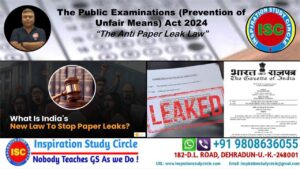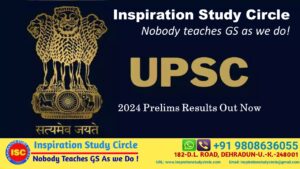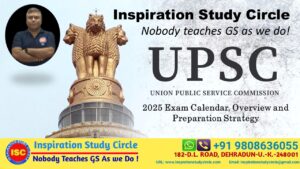
Inspiration Study Circle Explained: National Gopal Ratna Awards
The Department of Animal Husbandry and Dairying under the Ministry of Fisheries, Animal Husbandry and…
In the recent context of events, the Prime Minister Modi-led Indian Government has announced a list of esteemed names for the most established and prestigious Bharat Ratna Award for the year 2024.
The Highest Civilian Award, ‘Bharat Ratna’ is being presented to: –

The Bharat Ratna (Jewel of India) is the highest civilian award of the Republic of India. Instituted on 2 January 1954, the award is conferred in recognition of “exceptional service/performance of the highest order”, without distinction of race, occupation, position, or gender. The award was originally limited to arts, literature, science, and public service achievements. The Government of India expanded the criteria to include “any field of human endeavor” in December 2011.
The Prime Minister makes the recommendations for the award to the President. The recipients receive a Sanad (certificate) signed by the President and a Peepal leaf-shaped medallion with no monetary grant associated with the award. Bharat Ratna recipients rank seventh in the Indian order of precedence.
He was an eminent socialist leader and two-time Chief Minister of Bihar. He is widely regarded as a ‘Jan Nayaka’ (people’s hero) and champion of the backward classes. He implemented the first reservation policy for the most backward castes in Bihar in 1978. He enforced the complete prohibition of alcohol and established many educational institutions in the state. He is being awarded the Bharat Ratna for his outstanding contributions to social justice and empowerment.
In Bihar, Thakur is widely acclaimed for his pioneering initiative in implementing a complete ban on alcohol in 1970. This significant move earned him profound recognition, leading to the renaming of his birth village in the Samastipur district to Karpuri Gram in his honor.
Thakur’s political trajectory was marked by several notable milestones. He served as a minister and Deputy Chief Minister of Bihar, ultimately making history as the first non-Congress socialist Chief Minister of the state, firstly in 1970 and later in 1977. His tenure as Chief Minister was distinguished by the steadfast enforcement of the total prohibition of alcohol in Bihar, underscoring his steadfast commitment to social reform.
He was the ninth Prime Minister of India and the first from South India. He was widely recognized as the Father of Economic Reforms in India in 1991 when he initiated the Liberalization and Globalization of the Indian economy. He has steered the country through several crises including the balance of payments crisis, the Babri Masjid demolition, and the Kashmir insurgency. A scholar, polyglot, and author of several books, he is being awarded the Bharat Ratna for his visionary leadership and multifaceted legacy as a leader who transformed India.
Rao is remembered for his important role in bringing about economic reforms in India, particularly his efforts to end the rigid bureaucratic regime known as the License Raj. His contributions had a lasting impact on Indian politics and economic policy and established him as a great statesman.
Over his illustrious career, he held several significant portfolios, including Minister of Law and Information (1962-1964), Law and Endowments (1964-1967), Health and Medicine (1967), and Education (1968-1971) within the Government of Andhra Pradesh. Rao further served as the Chief Minister of Andhra Pradesh from 1971 to 1973 and held the position of General Secretary of the All-India Congress Committee from 1975 to 1976.
He was the fifth Prime Minister of India and a prominent farmer leader. He enormously supported the rights of farmers and rural development. He also introduced several policies and schemes for the welfare of farmers and the poor. He stood against the emergency and advocated democratic values. Regarded as a ‘champion of peasants’, he is credited with creating a new political class encompassing farming communities in North India. As a people’s representative, he took up issues concerning the village economy, building up a political position against the exploitation of peasants by big landlords.
After independence, he was one of the most important Congress leaders in UP, serving as MLA from Baghpat West (1952) and Kotana (1957, 1962). As the revenue minister in the cabinet of UP’s first chief minister Govind Ballabh Pant, he played a key role in implementing the historic legislation for the abolition of zamindari and land tenure.
In time, Charan Singh emerged as one of the most prominent leaders of the farming communities of Muslim North India, including Jats, Adavas, Gujars, and Kurmis.
He is being awarded the Bharat Ratna for his unparalleled contribution to the country and his unwavering commitment to the welfare of farmers.
He was a renowned agricultural scientist and the chief architect of the Green Revolution in India. He is the legend who introduced high-yielding varieties of wheat and rice that increased food production and saved millions of people from starvation. Since those times, biodiversity has made important contributions in the field of biotechnology and environmental protection.
Revered as the ‘Father of the Green Revolution’, he played a pivotal role in revolutionizing farming practices in the 1960s and ‘70s, thereby contributing significantly to India’s achievement of food security. He founded the Swaminathan Research Foundation that works for sustainable agriculture and rural development. He held key positions such as Independent Chairman of the Food and Agricultural Organisation Council (1981-1985), President of the International Union for the Conservation of Nature and Natural Resources (1984-1990), and President of the World-Wide Fund for Nature (India) from 1989 to 1996. Additionally, he served as the Director General of the Indian Council of Agricultural Research (ICAR), among other notable roles.
He is being awarded the Bharat Ratna for his important role in ensuring India’s food security and prosperity and his invaluable work as an innovator and educator.
A veteran leader of the Bharatiya Janata Party (BHJ), he served as Deputy Prime Minister and Home Minister of India. While being an active member of the national party, he initiated several reforms in security, defense, and media. He is being awarded the Bharat Ratna for his immense contribution to the development of India and distinguished services in various fields.
On 2 January 1954, a press communique was released from the office of the secretary to the President announcing the creation of two civilian awards—Bharat Ratna (Jewel of India), the highest civilian award, and the three-tier Padma Vibhushan, classified into “Pehla Warg” (Class I), “Dusra Warg” (Class II), and “Tisra Warg” (Class III), which rank below the Bharat Ratna.
General Trivia: On 15 January 1955, the Padma Vibhushan was reclassified into three different awards; the Padma Vibhushan, the highest of the three, followed by the Padma Bhushan and the Padma Shri.
The Bharat Ratna is conferred “in recognition of exceptional service/performance of the highest order” without distinction of race, occupation, position, or gender. The award was originally confined to the arts, literature, science, and public services, as per the 1954 regulations. In December 2011, the rules were amended to “any field of human endeavor”.
Usage of the title ‘Bharat Ratna’ as a prefix by the awardee is exempt from Article 18 (1) of the Constitution, as per the Supreme Court’s precedent in Balaji Raghavan/S.P. Anand v. Union of India in 1995.
Additionally, recipients may either use the expression “Awarded Bharat Ratna by the President” or “Recipient of Bharat Ratna Award” to indicate that they have been honored with the award.
The 1954 statutes did not allow posthumous awards, but this was subsequently modified in the January 1966 statute, and Lal Bahadur Shastri became the first recipient to be honored posthumously in 1966.
As with many official announcements, recipients are announced and registered in The Gazette of India, a publication released by the Department of Publication, Ministry of Urban Development used for official government notices; without publication in the Gazette, the conferral of the award is not considered official. Recipients whose awards have been revoked or restored, both of which require the authority of the President, are registered in the Gazette. Recipients whose awards have been revoked are required to surrender their medals, and their names are struck from the register.
Bharat Ratna cannot be used as a prefix or suffix however recipients may identify themselves as “Awarded Bharat Ratna by the President” or “Recipient of Bharat Ratna Award”. The award does not carry any monetary benefits, but the award includes the following entitlements:
For the first time in the history of independent India, the ruling government announced five Bharat Ratna awards in one year. Before this, it was the year 1999 that Bharat Ratna was awarded to four dignitaries. Back then, those who were awarded Bharat Ratna included Jayaprakash Narayan (Posthumous), Professor Amartya Sen, Lokpriya Gopinath Bordoloi (Posthumous), and Pandit Ravi Shankar.
Disclaimer: the above-mentioned article is based on information from the Indian Express and Wikipedia.

The Department of Animal Husbandry and Dairying under the Ministry of Fisheries, Animal Husbandry and…

The center draws attention to anti-paper leak law amid the row of NEET and UGC NET exams: Rs 1 crore fine, up to 10 years in jail for offenders……

The Krishi Sakhi Program is an initiative implemented in various states of India to empower women …..
The Union Public Service Commission (UPSC) is all set to conduct its CSE Prelims Exam, tentatively on 26th May 2024…

The Union Public Service Commission (UPSC) released the results of the Prelims …

Union Public Service Commission (UPSC) has announced the Exam….